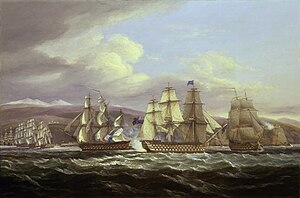Action of 5 November 1813
| Action of 5 November 1813 | |||||||
|---|---|---|---|---|---|---|---|
| Part of The Napoleonic Wars | |||||||
 The Blockade of Toulon, 1810-14: Pellew's Action, 5 November 1813, Thomas Luny, 1830, National Maritime Museum. |
|||||||
|
|||||||
| Belligerents | |||||||
|
|
|
||||||
| Commanders and leaders | |||||||
| Vice-Admiral Sir Edward Pellew | Rear-Admiral Julien Cosmao-Kerjulien | ||||||
| Strength | |||||||
| 13 ships of the line | 5 ships of the line, 4 frigates | ||||||
| Casualties and losses | |||||||
| 1 killed 14 wounded |
17 wounded | ||||||
The Action of 5 November 1813 was a brief naval clash during the Napoleonic Wars, between part of the British Mediterranean Fleet led by Vice-Admiral Sir Edward Pellew, and a French force under Rear-Admiral Julien Cosmao-Kerjulien. The engagement took place outside the French port of Toulon.
The clash occurred when a French fleet under Vice-Admiral Maxime Julien Émeriau de Beauverger took advantage of a favourable wind and the temporary absence of the British blockading force, to leave port to carry out exercises. Émeriau abandoned the exercises when the wind changed, but while returning to port his rear came under attack from the recently returned British inshore squadron. The British attack was reinforced by newly arrived ships from the main fleet, but the French were able to escape into Toulon after exchanging cannon fire with the British. Casualties on both sides were light.
The French Mediterranean Fleet had been blockaded in their principal base at Toulon for several years. Their commander from early 1811, Vice-Admiral Maxime Julien Émeriau de Beauverger made occasional sorties from the port in order to exercise his fleet, but preferred to avoid any chance of action with the patrolling British fleet under Vice-Admiral Sir Edward Pellew. Émeriau instead preferred to make brief sorties when the wind was in his favour and the British were absent, undertake exercises, and then return to Toulon when Pellew's fleet appeared. Pellew in turn hoped to tempt the French out and then cut them off from their homeport, forcing a decisive battle upon them. To this end he kept the main part of his fleet, including his largest ships, some distance from Toulon, and relied on a small inshore squadron composed of 74-gun ships to maintain the blockade. Strong gales in late October 1813 had forced both the inshore squadron and the main battlefleet off their stations, and Émeriau decided to make a sortie to exercise his fleet off Cape Sicié.
The French fleet, consisting of between twelve and fourteen ships of the line, six frigates and a schooner duly put to sea at 9:30 am on the morning of 5 November. Émeriau, flying his flag aboard the Impérial, was assisted in his manoeuvres by a strong east-north-east wind and made for the usual exercise area. The British inshore squadron, commanded by Captain Henry Heathcote, had only arrived back on their station the night before, and the main British fleet under Sir Edward Pellew was some distance to the south. Heathcote, commanding four 74-gun ships, was observing the French movements, when at 11:30 am, the wind suddenly changed direction, shifting to the north-west. Concerned about the sudden arrival of the British and unfavourable winds, Émeriau abandoned the exercises and ordered the fleet to make for Toulon. The advanced squadron of the French fleet, commanded by Rear-Admiral Julien Cosmao-Kerjulien and consisting of five ships of the line and four heavy frigates, now found itself to leeward, beating back to port. Heathcote immediately saw a chance to cut off the French rear, and ordered his squadron to attack.
...
Wikipedia
